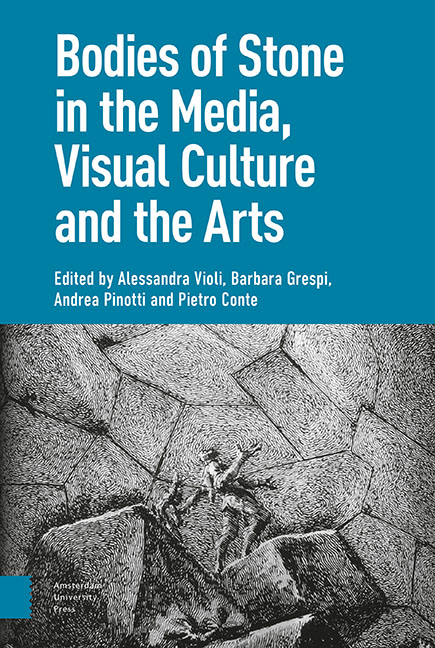Book contents
- Frontmatter
- Contents
- Introduction: Learning from Stone
- I Statue: The Imaginary of Uncertain Petrification
- 1 Theatre and Memory: The Body-as-Statue in Early Modern Culture
- 2 Translated Bodies: A ‘Cartographic’ Approach
- 3 Pantomime in Stone: Performance of the Pose and Animal Camouflage
- 4 Animated Statues and Petrified Bodies: A Journey Inside Fantasy Cinema
- 5 The Ephemeral Cathedral: Bodies of Stone and Configurations of Film
- II Matter: Size, Hardness, Duration
- 1 Bodies That Matter: Miniaturisation and the Origin(s) of ‘Art’
- 2 Brancusi’s ‘Sculpture for the Blind’
- 3 Cinema, Phenomenology and Hyperrealism
- 4 Ephemeral Bodies: The ‘Candles’ of Urs Fischer
- 5 The Celluloid and the Death Mask: Bazin’s and Eisenstein’s Image Anthropology
- III Corpse: Fossils, Auto-Icons, Revenants
- 1 Funeral Eulogy: Post-Mortem Figures and Redeemed Bodies, in Images
- 2 On Jack Torrance As a Fossil Form
- 3 Technical Images and the Transformation of Matter in Eighteenth-Century Tuscany
- 4 Glass, Mixed Media, Stone: The Bodily Stuffs of Suspended Animation
- 5 Bodies’ Strange Stories: Les Revenants and The Leftovers
- IV Monument: Embodying and Grafting
- 1 The Impassibly Fleshly, the Statue of the Impossible
- 2 Frozen into Allegory: Cleopatra’s Cultural Survival
- 3 The Orphan Image
- 4 The Well-Tempered Memorial: Abstraction, Anthropomorphism, Embodiment
- 5 Monuments of the Heart: Living Tombs and Organic Memories in Contemporary Culture
- Index
3 - Pantomime in Stone: Performance of the Pose and Animal Camouflage
Published online by Cambridge University Press: 20 November 2020
- Frontmatter
- Contents
- Introduction: Learning from Stone
- I Statue: The Imaginary of Uncertain Petrification
- 1 Theatre and Memory: The Body-as-Statue in Early Modern Culture
- 2 Translated Bodies: A ‘Cartographic’ Approach
- 3 Pantomime in Stone: Performance of the Pose and Animal Camouflage
- 4 Animated Statues and Petrified Bodies: A Journey Inside Fantasy Cinema
- 5 The Ephemeral Cathedral: Bodies of Stone and Configurations of Film
- II Matter: Size, Hardness, Duration
- 1 Bodies That Matter: Miniaturisation and the Origin(s) of ‘Art’
- 2 Brancusi’s ‘Sculpture for the Blind’
- 3 Cinema, Phenomenology and Hyperrealism
- 4 Ephemeral Bodies: The ‘Candles’ of Urs Fischer
- 5 The Celluloid and the Death Mask: Bazin’s and Eisenstein’s Image Anthropology
- III Corpse: Fossils, Auto-Icons, Revenants
- 1 Funeral Eulogy: Post-Mortem Figures and Redeemed Bodies, in Images
- 2 On Jack Torrance As a Fossil Form
- 3 Technical Images and the Transformation of Matter in Eighteenth-Century Tuscany
- 4 Glass, Mixed Media, Stone: The Bodily Stuffs of Suspended Animation
- 5 Bodies’ Strange Stories: Les Revenants and The Leftovers
- IV Monument: Embodying and Grafting
- 1 The Impassibly Fleshly, the Statue of the Impossible
- 2 Frozen into Allegory: Cleopatra’s Cultural Survival
- 3 The Orphan Image
- 4 The Well-Tempered Memorial: Abstraction, Anthropomorphism, Embodiment
- 5 Monuments of the Heart: Living Tombs and Organic Memories in Contemporary Culture
- Index
Summary
Abstract
This essay addresses cinema slapstick stars as figures of the body poised between flesh and stone: by matching the gestures of stone with those both of the statue and of the mineral as such, the silent actor becomes the emblem of how a body can be de-animated in a way that evokes at once certain pathological states and the freezing of a mimetic animal. Analysing in particular Charlie Chaplin's work with gesture in his first encounters with statues and in the famous “fight” with the marble group of City Lights(1933), the paper interrogates the aesthetic meaning of the pose within the wider process of the de-humanising of the actor's body as theorised in early film theories, in which one leading model was animal mimicry.
Keywords: Statue; mimicry; acting; film theories; slapstick comedy
The gestural expressions of actors and the way in which they interpret the environment and interconnect with objects, positioning the human being in space, express a thought about the body that cinema has continued to elaborate throughout its history. Because of its capacity to produce similarities even among very different entities, imitative gesture in particular has often been discussed in theories of acting and constantly practiced by actors with ever new shades of meaning.
The phenomenon of animal camouflage reinterpreted by Roger Caillois in the 1930s can be taken as a paradigm to understand the thought of the body that cinema developed around a very particular form of imitation: that in which the actor takes as a reference point some mineral object, even one that is not itself anthropomorphic. Although Caillois weaves a net of correspondences between the animal and the human, first and foremost defining mimicry as a form of creativity, he nevertheless tends to keep apart the behaviours of the two kingdoms, distinguishing the empirical and corporeal mode of the animal from the symbolic and rational mode of the human being. As his thesis famously put it, the cellular metamorphoses of the animals represent the biological equivalent of the mythical storytelling elaborated by the humans. Animals are capable of producing a regression toward lower states of life, of simulating death through perfect petrifications that are plausible and in part real in their corresponding to a condition of self-negation, and finally they are able to experiment with invisibility by blending with the environment.
- Type
- Chapter
- Information
- Publisher: Amsterdam University PressPrint publication year: 2020



